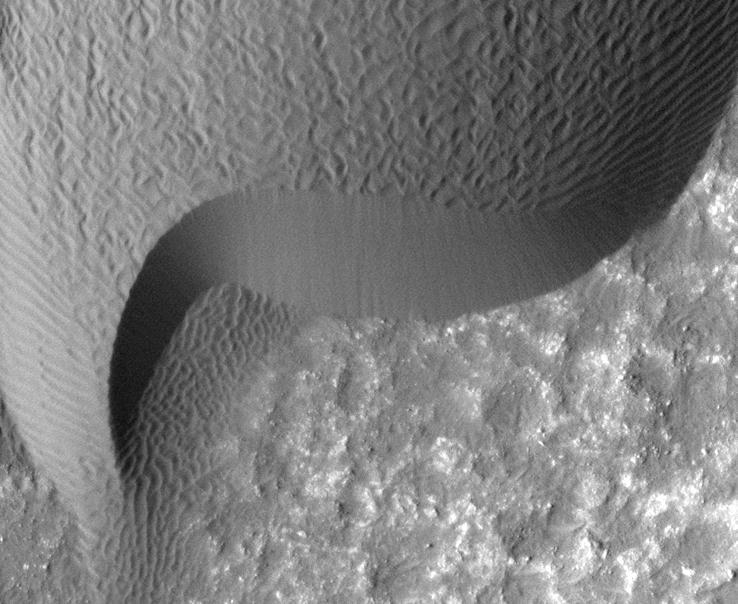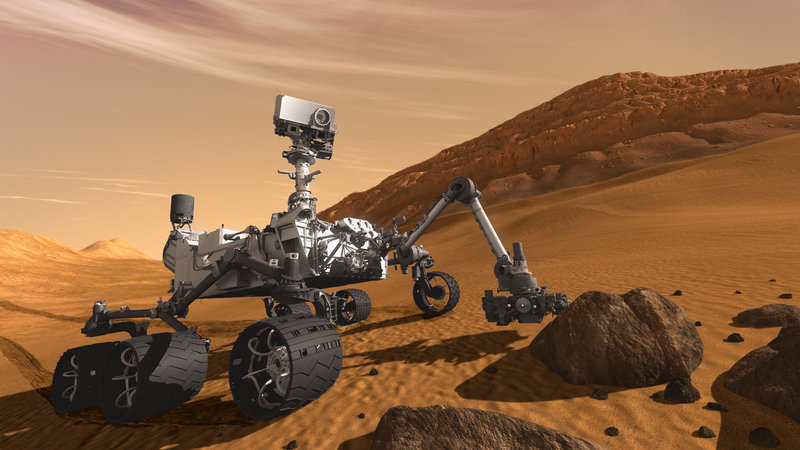NASA’s most ambitious, high-stakes, planetary mission in decades is scheduled to launch this week with a goal right out of science fiction: to learn whether Mars was, or ever could be, home to extraterrestrial life.
If the unmanned Mars Science Laboratory lifts off and travels a 354 million-mile path to Mars, it will lower to the surface a sedan-size rover called Curiosity, which has the potential to change our understanding of the cosmos.
The $2.5 billion mission comes at a crucial time for NASA. The agency faces intense budget scrutiny as it seeks to find a post-space-shuttle identity. Furthermore, NASA is under great pressure to justify its spending. With the project 30 percent over budget and two years late, much rides on its outcome.
A failure would embolden doubters who argue that the country can’t afford NASA.
A success could do the opposite and possibly lead the way to further exploration and a push to send astronauts to the planet.
“With this mission, we really enter the modern era of astrobiology, the search for life beyond Earth,” said James Green, NASA’s director of planetary sciences. “And we have the technology and know-how to make some extraordinary discoveries.”
While the agency’s past six Mars missions have succeeded, flying to our nearest planetary neighbor remains inherently difficult. Overall, more than two-thirds of the 43 Mars missions — including flybys, orbiters and landers — attempted by space agencies around the world have failed.
In addition, NASA is attempting something it has never done in the science-lab mission: It will use a new multistage landing system to lower the one-ton rover on a tether that some are likening to a “sky crane.” If it succeeds, the system is expected to be the prototype for rover landings on Mars and elsewhere.
The Mars Science Laboratory was initially scheduled to launch in 2008, but technical problems remained unsolved in the months before liftoff and cost overruns made them impossible to fix quickly.
The new window to launch opens Friday and lasts about three weeks. If all goes according to plan, the spaceship will get to Mars in August.
Despite attempts by Russia and other nations, the United States is the only country that has flown to Mars and landed a working spacecraft on its surface. (The Soviets touched down twice, but the landers failed.) NASA has had a successful Martian touchdown and mission six times, including its two Viking landers in 1976.
Viking was a fledgling life-detection mission, but the scale of the Curiosity endeavor is so much greater than past efforts that many are putting it into a category of its own.
The rover is twice as long as the next-largest ever sent into space, and it will carry 10 of the most sophisticated science instruments ever deployed. It can also drill holes in the surface, shoot lasers at rocks and analyze the chemical content in the resulting spark, and drive as far as 12 miles in its almost two-year lifetime. In addition, scientists have the benefit of 35 additional years of research into conditions on Mars and what life needs to survive.
The rover is supposed to land near the base of a 3-mile high, layered mountain inside the Gale Crater. Curiosity is designed to climb the mountain and investigate whether any of those layers, formed during Martian eras, preserved evidence of conditions favorable for the genesis and survival of microbial life.
Curiosity will be looking for evidence that water once ran on or near the surface in what is now the central Gale Crater mountain. “Follow the water” has long been NASA’s mantra for Mars exploration, because liquid water is believed to be necessary (though not sufficient) for life.
“The portion of the crater where Curiosity will land has an alluvial fan likely formed by water-carried sediments,” said John Grotzinger, project scientist for the Mars Science Laboratory at the California Institute of Technology in Pasadena. “Layers at the base of the mountain contain clays and sulfates, both known to form in water.”
One of the primary goals of MSL, however, is to go beyond “follow the water” to the question of “habitability.” Scientists want to search for signs other than the ancient presence of water to assess whether Mars does, or did, support biology.
“We want to know everything we can about the minerals, the carbon-based compounds, the temperatures, the chemistry of the micro-environments we look at,” said Pamela Conrad an investigator at NASA’s Goddard Space Flight Center. By comparing data with potentially similar environments on Earth, the team hopes to find clues about potential livability at the sample site.
Ironically, one reason Gale Crater was selected is that it is not as likely as some other places on Mars to have areas of current habitability. Curiosity was not baked clean before launch to the same degree as the Viking landers — because of the extreme expense and possibility of harming some of the instruments — and therefore it could carry earthly microbes.
While microbes are unlikely to survive the harsh surface of Mars, “planetary protection” guidelines say that approaching areas most likely to have any remnant life requires a higher level of sterilization than the arriving rover has.
To unknowingly take microbes to Mars and then detect them or their organic remains is a worry.
But this doesn’t mean Curiosity lacks the potential to make discoveries that strongly suggest current or past life. For instance, NASA’s Green said its instruments can determine whether carbon in the soil has the isotopic signature associated with life.
Curiosity also has instruments that can detect minuscule amounts of methane, a gas that is similarly associated with life on Earth.
The only other NASA mission to Mars on this scale was Viking, the 1976 life-detection trip. The United States landed two spacecraft, which sent information back to Earth for 3 1/2 and six years. NASA concluded that no signs of life were found, although the principal investigator of one of the key biological tests, Gilbert Levin of Bethesda, has argued for decades that his experiment found evidence of metabolism.
The Viking experiment that swayed the debate within NASA was unable to find organic material on Mars – the complex carbon and hydrogen molecules essential for life as we know it. This result illustrated the limits of the Viking science, as it has since been well-established that organics constantly fall from space onto Earth, and presumably onto other celestial bodies as well.
MSL and Curiosity will revisit organics and use far more sophisticated instruments to search for them. The discovery of the material would not necessarily mean that life is, or was, on Mars, but it would significantly improve the case.
“I don’t think there’s any doubt that this is one of the most important science missions in NASA history,” said Chris Carberry, executive director of the Explore Mars advocacy group. “The combination of its ambitions and its timing are extraordinary.”
Copy the Story Link
Send questions/comments to the editors.




Success. Please wait for the page to reload. If the page does not reload within 5 seconds, please refresh the page.
Enter your email and password to access comments.
Hi, to comment on stories you must . This profile is in addition to your subscription and website login.
Already have a commenting profile? .
Invalid username/password.
Please check your email to confirm and complete your registration.
Only subscribers are eligible to post comments. Please subscribe or login first for digital access. Here’s why.
Use the form below to reset your password. When you've submitted your account email, we will send an email with a reset code.